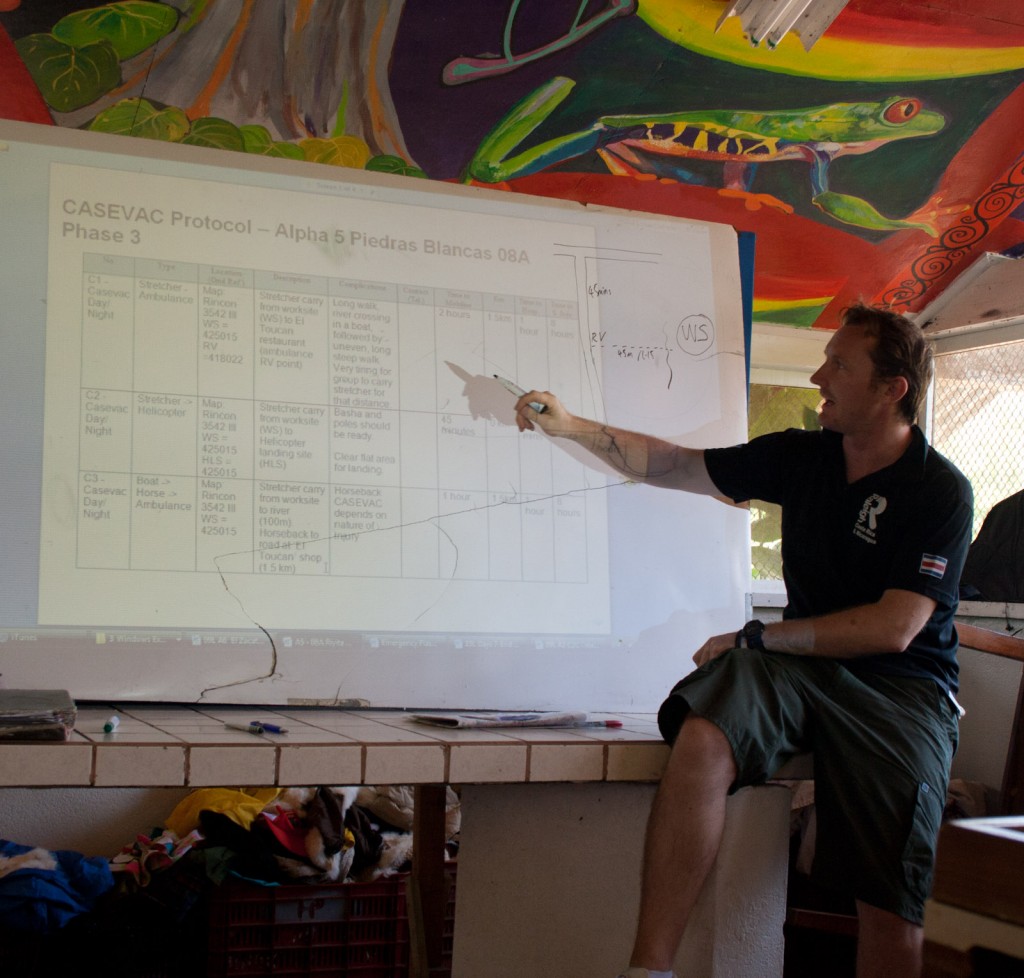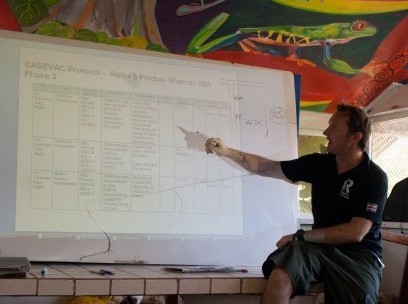 After a lot of fun learning radio comms, but today Ross gets serious on the procedures for medical and casualty evacuations … known as MEDIVACS and CASEVACS, casevacs being the more serious,with immediate moves to hospital. Now this sounds like a bunch of theory, like much health and safety training back in the UK. However the previous expedition had to casevac a venture out through the jungle on a stretcher, a gruelling days hike in sweltering heat to the nearest road, with a bunch of 17 to 20 olds used to soft city living.
After a lot of fun learning radio comms, but today Ross gets serious on the procedures for medical and casualty evacuations … known as MEDIVACS and CASEVACS, casevacs being the more serious,with immediate moves to hospital. Now this sounds like a bunch of theory, like much health and safety training back in the UK. However the previous expedition had to casevac a venture out through the jungle on a stretcher, a gruelling days hike in sweltering heat to the nearest road, with a bunch of 17 to 20 olds used to soft city living.
So every project has a casevac plan, treks casevacs are more fluid with the trek leaders needing to keep in mind as they are trekking of the best evacuation points (helicopter or road) or whether to go back or continue trekking onwards. Every project site has a plan indicating best route out, transport available (foot, car, horse, helicopter), time to rendezvous evacuation point, time from RV to nearest clinic or hospital.
Fieldbase and the project team follow the same comms format which allows all critical information to be transferred quickly and efficiently, especially important for fieldbase to receive correctly and reduce any panic in field:
Serial Alpha: Grid Ref; Local landmarks
Serial Bravo: Nature of injury/injuries
Serial Charlie: ID Nos (participant Id are used rather than names)
Serial Delta: Treatment administered on scene
Serial Echo: Description of incident
Serial Foxtrot: Update of assistance req.
Serial Golf: Comms plan for next contact
Serial H: decision to inform next of kin
An example casevac plan looks like this:
| No. | Type | Location (Grid Ref.) | Description | Complications | Time to Mobilise | Time to Hosp. | Time to S. Jose |
| C1
|
Stretcher – Ambulance | Map: Rincon 3542 III
WS = 425015 RV =418022 |
Stretcher carry from worksite (WS) to El Toucan restaurant (ambulance RV point) | Long walk, river crossing in a boat, followed by uneven, long steep walk.
Very tiring for group to carry stretcher for that distance. |
2 hours | 1 hour | 8 hours |
| C2
|
Stretcher ->
Helicopter
|
Map: Rincon 3542 III
WS = 425015 HLS = 425015 |
Stretcher carry from worksite (WS) to Helicopter landing site (HLS) | Basha and poles should be ready.
Clear flat area for landing. |
45 minutes | 15 mins | 2 hours |
| C3
|
Boat ->
Horse -> Ambulance |
Map: Rincon 3542 III
WS = 425015
|
Stretcher carry from worksite to river (100m). Horseback to road at ‘El Toucan’ shop (1.5 km) | Horseback CASEVAC depends on nature of injury
|
1 hour
|
1 hour
|
8 hours |
Just in case we think this is all a bit overkill, we get a few stories of recent expedition casevacs, including one from Wellard where she and her team had to stretcher a guy out over two days of trekking up and downhill, through mud, sweat and tears carrying all their packs and the casualty. Another project on the coast had a casevacs on the both the first and second day of phase 1.
However our team managed to beat the record of a day 1 medivac with one of our own as we left for jungle camp training.
